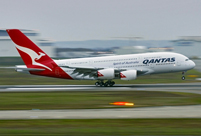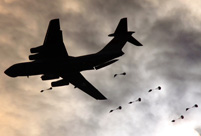 Ballerinas anywhere but onstage
Ballerinas anywhere but onstage
 Top 10 safest airlines in the world
Top 10 safest airlines in the world
 Top 10 most popular instant messaging apps in the world
Top 10 most popular instant messaging apps in the world
 Inspiring shadow images of Chinese army
Inspiring shadow images of Chinese army
 Models shine Xinjiang auto show
Models shine Xinjiang auto show
 From laid-off worker to int'l referee in bodybuilding
From laid-off worker to int'l referee in bodybuilding
 Selected photos of 'two sessions'
Selected photos of 'two sessions'
 Most unusual taxis around the world
Most unusual taxis around the world
 Bridge Worship Festival in Taijiang, SW China
Bridge Worship Festival in Taijiang, SW China
KUALA LUMPUR, March 28 -- Refining the search area for MH370 continued on Friday with "unprecedented" resources concentrating on finding the debris spotted by satellites, an official said.
Australian authorities have indicated that they have shifted the search area about 1,100 km to the north east.
Because of ocean drift, this new search area could still be consistent with the potential objects identified by various satellite images over the past week.
The international working group included representatives from Britain, namely Inmarsat, AAIB, and Rolls Royce; from China, namely the CAAC and AAID; from the United States, namely the NTSB, FAA, and Boeing; as well as the relevant Malaysian authorities are engaged in narrowing the search area.
"Information which had already been examined by the investigation was re-examined in light of new evidence drawn from the Inmarsat data analysis," Malaysian acting Transport Minister Hihammuddin Hussein said, adding that the area could be further refined in the next few days.
Meanwhile, international partners, the latest being Japan, which continue to process data in their home countries, as well as in the international working group, have further refined existing data. They have also come up with new technical information, on aircraft performance, for example.
On Thursday, this process yielded new results, which indicated that MH370 flew at a higher speed than previously thought, which in turn means it used more fuel and could not travel as far. This information was passed to Rescue Coordination Center, Australia by the NTSB, to help further refine and narrow the search area.
The new search area, about 1,680 km west of Perth, remains in the Australian area of responsibility.
Australia continues to lead the search efforts in this new area, and the Australian Maritime Safety Authority gave a comprehensive operational update earlier on Friday.
As more information emerges, they will be issuing frequent operational updates, including on assets by countries deployed to find MH370, which has now been missing for 20 days.
"I would like to echo their statements that the new search area, although more focused than before, remains considerable; and that the search conditions, although easier than before, remain challenging," Hussein noted.
The black box locator being flown in from the United States will be fixed to an Australian ship and is expected to reach the search site on April 5. However, even if the "ping" of the black box is not found, Hussein assured that the search would continue with authorities already looking at deep sea surveillance options to find debris.
One of the biggest challenges is that it takes about 3-4 hours for ships to reach the search area and have to return after only two hours of searching to refuel. Hussein also commiserated with the families of those lost on MH370 and assured that their investigation has been competent and transparent.
He urged relatives not to "get carried away" on speculations and said "history would judge" the work done by the Malaysian government.
"I say to Chinese families it's not just them looking for family members. Malaysians also and people from 14 other nations have also lost family members. We are continuing to engage them."
 Female journalists at 'two sessions'
Female journalists at 'two sessions' Interpreters serving 'two sessions'
Interpreters serving 'two sessions' Female SWAT team in Chongqing
Female SWAT team in Chongqing Top 10 safest airlines in the world
Top 10 safest airlines in the world Old photos of Anti-Japanese War
Old photos of Anti-Japanese War Mysterious 'Dolan Tribe' in Xinjiang
Mysterious 'Dolan Tribe' in Xinjiang A bite of Luoping County
A bite of Luoping County This is Shanghai
This is Shanghai Chinese airborne troops complete parachute training in various training bases
Chinese airborne troops complete parachute training in various training bases Ballerinas anywhere but onstage
Ballerinas anywhere but onstage Most unusual taxis around the world
Most unusual taxis around the world Micro-expression at 'two sessions'
Micro-expression at 'two sessions' Bridge Worship Festival in Taijiang, SW China
Bridge Worship Festival in Taijiang, SW China Hollywood documentary brings Diaoyu Islands truth to new audience
Hollywood documentary brings Diaoyu Islands truth to new audience Miss HK and actresses shine at flower show
Miss HK and actresses shine at flower showDay|Week|Month